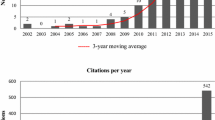Abstract
This note analyzes the results of Ben-Zion and Spiegel regarding different forms of transfer from rich persons to poor ones. Assuming a more general utility function, not necessarily additive or homothetic, this note shows that a combined policy of income transfer with specific subsidy to the poor consumer can lead to an optimal solution (first best) from the donor's point of view. If it is not possible to differentiate between consumers, a system of subsidy to all consumers can achieve a second best solution.
Similar content being viewed by others
References
Ben-Zion, U., and Spiegel, U. (1983). Philantropic motives and contribution policy. Public Choice 40(2): 117–133.
Fisher, F.M. (1977). On donor sovereignty and united charities. The American Economic Review 67(April): 632–638.
Author information
Authors and Affiliations
Additional information
This essay was written during my visit at the University of Pennsylvania.
Rights and permissions
About this article
Cite this article
Deutsch, J. Philantropic motives and contribution policy: A note. Public Choice 44, 501–505 (1984). https://doi.org/10.1007/BF00119696
Issue Date:
DOI: https://doi.org/10.1007/BF00119696




